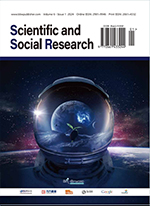Abstract
This paper discusses the evolution, cultural characteristics, and value of Chinese classic animated films incontemporary society. By analyzing the origin, development, and classic works of Chinese animation, this paper aims toreveal how these works have influenced China’s cultural heritage and modern animation industry. This paper describes theuniqueness of Chinese animated films in terms of artistic expression, storytelling, and cultural connotation, and how theyadapt to the challenges of the new era to find their place and value again.
References
Liu Y, 2022, Construction and Development of Chinese Animated Film “Community Aesthetics.” Comedy World: Zhong, 2022(09): 43–45.
Chen S, 2023, Aesthetic Inheritance and Evolution of Chinese Animated Films in the Context of National Culture: A Case Study of Nezha the Devil Child Comes into the World. Journal of Changzhou Institute of Technology: Social Science Edition, 2023(1): 86–91.
Han Y, 2023, Aesthetic Innovation of Nationalized Narrative in Chinese Animated Films from the Perspective of Cultural Revitalization. Film Review, 2023(17): 94–98.
Bu S, Guo J, 2023, Research on the Development Trend of Chinese Animated Films. Modern Audiovisual, 2023(6): 56–61.
Yan Han, Spatial Construction and Expression of “the Other” in Chinese Animated Films. Media, 2023(9): 90–93.
Tong T, Hu S, Visual Spectacle and Empathy Connection: The External Value Communication of Chinese Animated Films from a Cross-Cultural Perspective. External Communication, 2021(6): 22–26.
Liu X, Xia J, 2022, Research on Chinese Animation’s Bearing and Dissemination of Traditional Values. Film Literature, 2022(9): 81–86.
Zhao H, 2021, The Aesthetic Value Construction of Chinese Mythological Animated Films. Sound World, 2021(24): 46–47.
Li Y, 2022, From “Chinese School” to “Chinese Film School”: The System Construction of Chinese Film School. Journal of Hunan University of Science and Technology (Social Science Edition), 25(4): 118–127.
Liu X, 2022, The Shift of Critical Discourse and the Reconstruction of Critical Methodology in Chinese Animated Films in the 21st Century. Film Literature, 2022(4): 46–51.
Zhou Z, 2021, Aesthetic Value of Facial Mask Art in Chinese Animated Films [J], Art Education, 2021(8): 125–128.
Bao Y, 2020, A Study on Aesthetic Values of Contemporary Chinese Animated Films (1979-2019). Film Review, 2020(15): 57–60.
Yan L, 2019, Analysis of the Value Orientation of Villain Characters in Chinese Animated Films. Popular Literature and Arts, 2019(10): 176–177.
Wang X, Zhang S, 2017, Recent Introduction of Animated Films in China and its Implications for Domestic Animated Films. Art Baijia, 33(04): 88–93.
Li J, 2016, Aesthetic Development of Contemporary Chinese Animated Films. Film Literature, 2016(21): 104–106.
Ding Y, 2014, Exploration of the Formation of Traditional Aesthetic Style of Chinese Animated Films. Popular Literature and Art, 2014(20): 206.
Liu H, 2022, Aesthetic Research of Traditional Chinese Culture in Animated Films. Cultural Industry, 2022(36): 52–54.
Yin X, 2021, The Application of Formal Aesthetics in Domestic Animated Films. Film Literature, 2021(3): 64–65.
Hua Y, 2019, On Traditional Culture and its Contemporary Value in Domestic Animated Films. New Films, 2019(6): 101–103.
Chen X, Zhang L, 2018, Research on the Construction and Value of Double Reality in Contemporary Asian Reality-Themed Animated Films. Fine Arts Grand View. 2018(9): 120–121.
